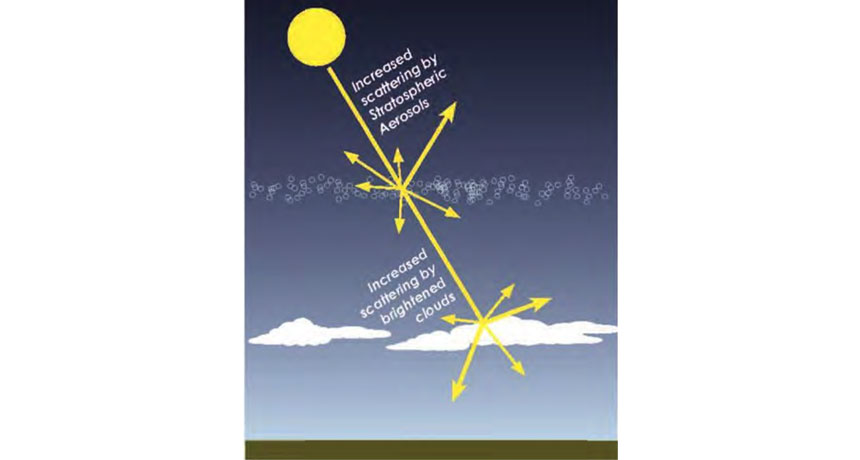
CLIMATE COOLERS Schemes to cool the planet, including spewing reflective particles or synthetic clouds in the atmosphere, are worth more study but not ready for a debut, experts say.
National Academy of Sciences
Scientists shouldn’t tinker with Earth’s climate — at least not yet, two new analyses conclude.
Schemes to manually lower the planet’s temperature and dodge devastating effects of climate change are still too immature, risky and costly to try now, assert the studies, released February 10 by the National Academies. But scientists should keep working on those plans, the reports say.
The two main plans are to suck planet-warming carbon dioxide straight out of the air and — the dicier plan — to shield the globe from the sun’s hot rays by reflecting them back into space. Each plan is reviewed in a separate report produced by the National Research Council, which produces reports to advise the federal government.
Research into even the riskiest ideas needs to continue, says climate scientist Waleed Abdalati of the University of Colorado in Boulder, a coauthor of the reports. Humans may one day find themselves in a climate emergency when the risks of doing nothing outweigh the risks of an intervention, he warns. “The only way to make a decision in an informed way is to understand those risks.”
The gentle encouragement to continue research is a boon to many in the small field of climate interventions. Also called geoengineering, the field has been plagued by controversy. (SN, 6/5/10, p. 16) Critics argue that the push for climate interventions could draw attention away from reducing the greenhouse gas emissions causing warming and ocean acidification. And researchers and policy makers alike are uneasy with tweaking planetwide climate, which could trigger a slew of unexpected and potentially unmanageable side effects.
“There’s a huge amount of concern about the future of climate,” says climate change scientist Claire Parkinson of NASA’s Goddard Space Flight Center in Greenbelt, Md., one of the scientists who reviewed drafts of the reports. But “we don’t want to make a mistake that’s even worse than what we’re trying to correct.”
Both reports were prepared by a panel of experts. In the first report, the council reviewed ways to cull carbon dioxide. Strategies include using plants or yet-to-be-developed devices to snatch the gas from air, then collect it and pump it deep underground for long-term storage. Such methods are either too costly or not ready for prime time, the council found. But they could be useful tools to help combat climate change in the future.
The other report had a harsher take on trying to reflect solar rays, saying it would be “irrational and irresponsible” to try it. For this method, researchers have suggested spraying tiny particles into the atmosphere that could reflect the warming radiation. This approach would in some ways mimic volcanic eruptions, which are known to have wide-scale (but temporary) cooling effects on the planet. Other ideas include generating synthetic cloud cover.
Implementing these ideas would merely be attempts to cool down the planet rather than counteracting the effects of carbon dioxide. Anytime humans stopped making fake clouds or spewing particles into the air, global warming would return. And particles and cloud cover would dim the planet, having unknown effects on crops and weather patterns.
Still, the council’s report says such a drastic and risky strategy may be needed to avoid a climate emergency.
If things ever get really bad, we don’t want to still be doing early-stage experiments, says international relations specialist David Victor of the University of California, San Diego. The council’s recommendation to keep doing research is an important step toward those backup plans. “It decisively opens the door,” to those plans, he says.
Physicist and climate scientist David Keith of Harvard University also welcomed the call for research, calling the council’s recommendation “fantastic.” And discussing these doomsday backup plans may even encourage people to start taking climate change seriously, he says.







